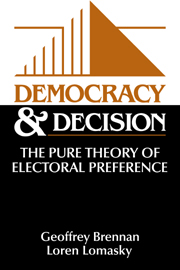Book contents
- Frontmatter
- Contents
- Preface
- 1 Ethics, politics, and public choice
- 2 The logic of electoral choice
- 3 The nature of expressive returns
- 4 The analytics of decisiveness
- 5 The theory of electoral outcomes: implications for public choice theory
- 6 From anecdote to analysis
- 7 Interpreting the numbers
- 8 Consensus, efficiency, and contractarian justification
- 9 Paternalism, self-paternalism, and the state
- 10 Toward a democratic morality
- 11 Constitutional implications
- Bibliography
- Index
7 - Interpreting the numbers
Published online by Cambridge University Press: 05 June 2012
- Frontmatter
- Contents
- Preface
- 1 Ethics, politics, and public choice
- 2 The logic of electoral choice
- 3 The nature of expressive returns
- 4 The analytics of decisiveness
- 5 The theory of electoral outcomes: implications for public choice theory
- 6 From anecdote to analysis
- 7 Interpreting the numbers
- 8 Consensus, efficiency, and contractarian justification
- 9 Paternalism, self-paternalism, and the state
- 10 Toward a democratic morality
- 11 Constitutional implications
- Bibliography
- Index
Summary
… fantastic rather than rigorous, enthusiastic rather than scientifically exact. Comment about Condorcet, quoted in Duncan Black,
Theory of Committees and ElectionsIntroduction
Some commentators will presumably find the evidence for the expressive theory of voting offered in the preceding chapter excessively anecdotal in character, with all the negative connotations that the anecdote carries in properly acculturated econometric circles. As we have made clear, we do not totally deprecate the anecdote as a source of information; but we concede the need to examine the relevant numbers in a systematic way, without retreat into “adhocery,” and that is a prime object of this chapter.
The most obvious source of relevant data here is that available on the voting behavior of individual voters. Does that evidence offer genuine support for the use of homo economicus as an appropriate behavioral abstraction in electoral politics? Does it offer any support for our expressive voter alternative? Beyond this evidence, is there any other information of a systematic kind that is relevant? What, for example, can we say about the behavior of politicians? In particular, is there econometrically respectable evidence indicating, pace public choice orthodoxy, that politicians may to some extent internalize the ethical/ideological principles that expressive voting suggests will be an important element in electoral contests? And what are we to make of the indirect evidence that has often been taken to lend support to the instrumental theory of voting? We have in mind particularly the literature on voter turnout and the tests of whether (and to what extent) voter turnout responds to expected closeness.
- Type
- Chapter
- Information
- Democracy and DecisionThe Pure Theory of Electoral Preference, pp. 108 - 123Publisher: Cambridge University PressPrint publication year: 1993



